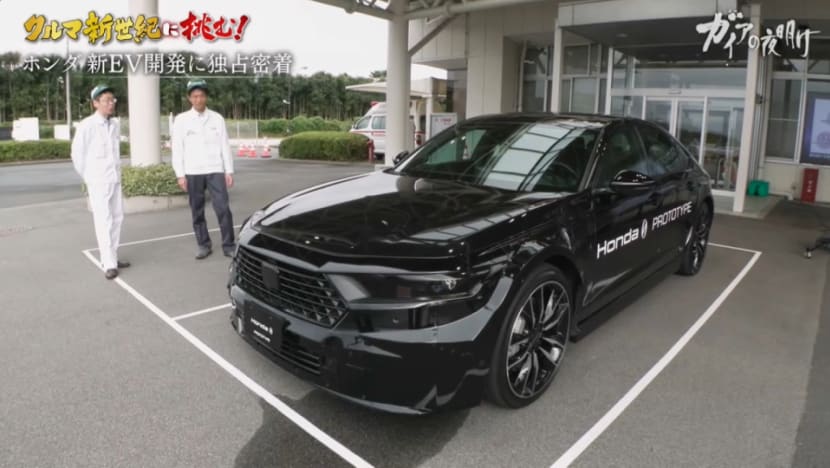Honda steps boldly into the electric age with a sweeping transformation that redefines Japanese car-making. In this episode, Japan Hour casts its lens on the Japanese automotive industry's pivotal transformation — with Honda charging ahead at full throttle. As 2024 draws to a close, the programme opens against a backdrop of seismic change: Two titans of Japanese motoring, Honda and Nissan, announce plans for a merger in response to mounting pressures from Chinese EV makers and ballooning development costs.
The central thread of the episode follows Honda’s ambitious "0 Series" initiative, a ground-up reinvention of how the company builds cars. Founded in 1948, Honda began by manufacturing motorcycles and now ranks eighth in the global automative industry, selling four million vehicles annually. It is fully embracing electrification, with Honda pledging that by 2040, all its new vehicles will be hybrid or fully electric.

“It’s a once-in-a-century transformation and a great opportunity for change,” says Honda president Toshihiro Mibe, who has led the company since 2021. The narrative zooms in on various sites across Japan and beyond, from the streets of Tokyo to the freezing test tracks of Hokkaido, and even the glitzy showrooms of Las Vegas. In Adachi Ward, we meet Koichi Kageno, a second-generation dry cleaner who represents a new wave of everyday EV adopters.
He proudly drives a Honda N-VAN e:, a light commercial EV that he bought for around 2.2 million yen (S$20,000) after subsidies. “From now on, what I care about isn’t gas prices, but the price of electricity,” he says, explaining how he slashed his petrol bill of about 12,000 yen a month.
Kageno's enthusiasm isn't just about cost. “Even with quite a bit of cargo loaded in the back, it still runs smoothly and strongly,” he beams, adding, “Honestly, I’m glad I bought it.” His story underscores how electric vehicles are beginning to resonate not just with early adopters, but also with small business owners whose needs are practical and immediate.
At the other end of the spectrum, Honda’s unveiling of the 0 Series at CES 2025 in Las Vegas is nothing short of cinematic. Under dramatic lighting, Honda’s sleek "Saloon" and SUV prototype, slated for release in 2026, signal a new design philosophy. “We want them to appear artistic,” explains design chief Toshinobu Minami at Honda’s newly-built development base in Wako City, Saitama.
Here, he works closely with modellers and sculptors to bring abstract sketches into aerodynamic reality. That dedication to craftsmanship extends to the test tracks, where engineers like Toshihiro Akiwa, who once specialised in engine development, now find themselves steering engine-less prototypes. “Honda has always been about engines,” he says wistfully.
“But now we’re transitioning. I really feel the heavy responsibility.” In Hokkaido, with snow crunching under tyres and mercury dipping to minus six degrees Celsius, the team tests posture control systems inspired by ASIMO, Honda’s legendary bipedal robot.
“It handles beautifully,” says chief engineer Tatsuya Mori. “Even people who aren’t confident drivers can feel safe.” If the 0 Series is Honda’s solo bid to reshape mobility, then AFEELA is its experimental duet, a co-venture with Sony that blends automotive engineering with digital innovation.
First announced in 2022, the AFEELA 1 made a splash at CES 2025 with a price tag starting around 14 million yen. To enable advanced automous driving, it is packed with 18 cameras, 40 sensors and voice-interactive AI; the vehicle feels more like a mobile tech hub than a traditional car. Sony Honda Mobility’s Vice President, Shugo Yamaguchi, who previously helped launch Sony’s Alpha camera, explains the gamble: “I imagine AFEELA will also take time to catch on, but it’s really fulfilling to see people enjoying it.
” His team is bypassing traditional dealerships altogether, opting instead for direct-to-consumer online sales in the United States, backed by a network of over 650 repair shops. The collaboration’s unorthodox strategy even includes showcasing AFEELA at a Los Angeles Dodgers game, where curious baseball fans eye the sleek prototype as though it just dropped from the future. One fan exclaims, “I want it! I need it! This is a necessity!” Meanwhile, the episode offers a stark reminder of the mounting competition from China.
At a bustling BYD dealership in Shanghai, the episode highlights how the Chinese EV manufacturer has become a global juggernaut. With 2024 sales at 4.27 million units, surpassing both Honda and Nissan, BYD’s rise is driven by cost control and in-house development, offering EVs up to one million yen cheaper than competitors.
One customer notes: “All my friends who bought BYD cars gave it good reviews.” This arms race is now being felt in Japan, where BYD recently opened its 35th dealership. In 2024 alone, it sold 2,223 EVs in Japan, overtaking even Toyota.
As the episode closes, Honda drops a surprise: ASIMO, the iconic humanoid robot, makes an unexpected comeback — not as a robot, but as the operating system for Honda’s next-gen vehicles. The ASIMO OS will run the car’s autonomous functions, navigation and even interactive features, in a poetic nod to Honda’s past and future. As the camera pans over engineers smiling beside their creations, Mr Mibe delivers the last word: “Only Honda already offers a full range of mobility options.
Even in 2050, every form of transportation will have ‘Honda’ written on it.”.
Top

Gaia Series 83: Taking On The Challenge Of The New Millennium Of Cars!

This episode sees how Honda's EV ambitions come to life through its innovative 0 Series and Sony partnership in its bold reboot.











